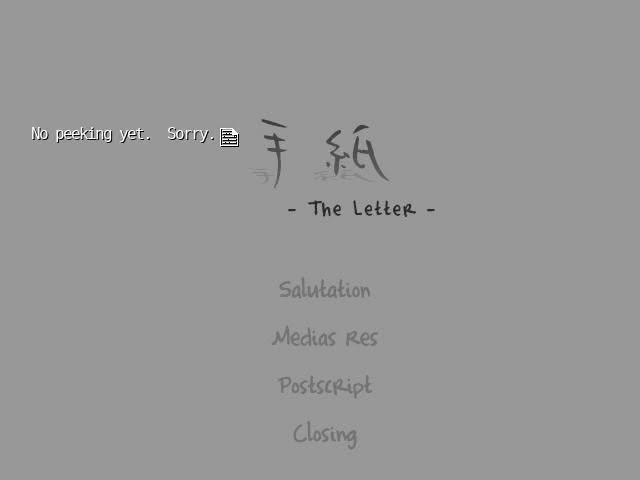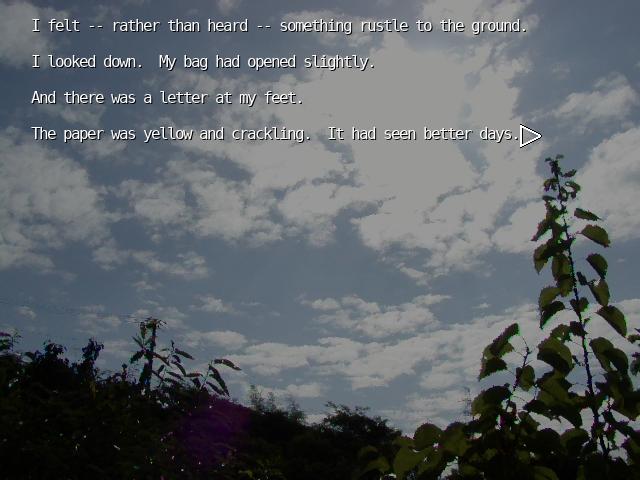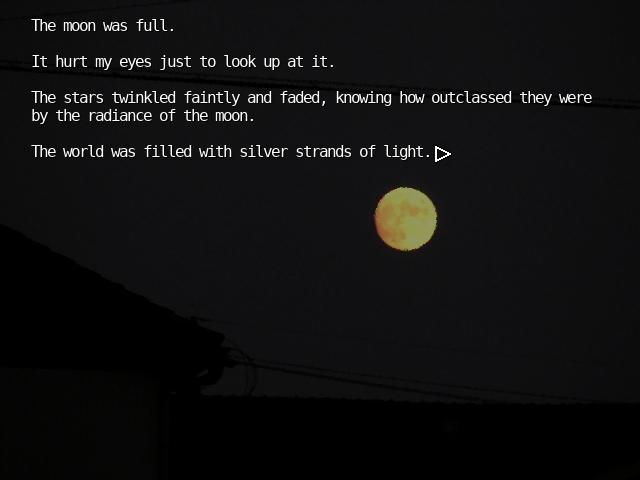The Letter is Insani’s 2008 translation of a freeware visual novel originally released in Japan as Tegami in 2005 and re-released with a new visual novel scripting engine (NScripter) in 2007. The original Japanese game was created by a visual novel circle called P.o.l.c. The translation was completed by Mr. Seung Park of Insani. I am reviewing The Letter as part of my project to review nearly all of the 31 visual Japanese visual novels translated and contributed to the 2005, 2006, and 2008 al|together festivals. The Letter is my 22nd review of the project.

You can learn more about my al|together project by reading my project introduction article. That article includes a running list of our completed al|together reviews. I have a dedicated collection post with links to all of our al|together articles, including reviews, essays, and short posts.
Save for three choices which only change a small amount of dialogue, The Letter is an entirely linear text-based visual novel. Like many of the al|together translations, The Letter is visually simple, featuring only photographic backgrounds to go with freeware music. We see the story from the perspective of a young college student named Takahiro Watanabe who is returning from Tokyo to his home in the rural Japanese countryside to visit his mother after spending a long time away. Takahiro carries with him a letter, which clearly has some connection to his father who had died after being hit by a car when Takahiro was young. The story features Takahiro reconnecting with his mother and, through some peculiar events, coming to make peace with his past and remembering the important things in life.
The Letter Details
English version
| Title | The Letter |
| Translator | Seung Park (Insani) |
| Release Date | November 29, 2008 |
| Engine | ONScripter-EN |
| Official Website | altogether 2008; Insani |
Japanese original
| Title | Tegami |
| Developer | P.o.l.c (archived) (Scenario by Wataru; Support from Tentama) |
| Original Release Date | October 13, 2005 |
| Second Release Date | January 15, 2007 |
| Engine | 2005 (Yuuki! Novel), 2007 (NScripter) |
| Official Website | Archived |
| Download | Yuuki! Novel ver; NScripter Version: Freem! and Erogamescape |

Notes: The first version of Tegami was created with a visual novel engine called Yuuki! Novel. P.o.l.c. re-wrote Tegami in 2007 (the main writer, Wataru, stated that the NScripter version is substantially similar to the original). Most of the Japanese novels translated for al|together were written in NScripter, and none other than The Letter were originally created with Yuuki! Novel (see my notes; archived). I was surprised to discover that the Yuuki! Novel version of the original is still available for download for those who can read Japanese and are interested in running a comparison. The al|together translation is based on the 2007 NScripter version of Tegami.
Running and installing The Letter
Insani offers Windows and MacOS downloads for The Letter. My understanding is that the MacOS version does not work on modern MacOS systems, but I have not tested it (it is possible that the newer versions of ONScripter-EN may work, but I cannot test for MacOS since I do not own any MacOS devices). I tested the Windows version on Linux on top of WINE using the original installer for The Letter and it ran without any problems. However, I reviewed The Letter running natively on Linux. First, I extracted the contents of the Windows .exe file into a new directory, as described here. Secondly, I added what was then the most recent ONScripter-EN build from the source repository (June 5, 2023 in my case) into the directory and running it from the command line. I recommend using the newest ONScripter-EN version (I recommend the same for Windows).
General overview of The Letter
Insani provides a very brief description of The Letter on its regular webpage for the translation:
Takahiro Watanabe comes home to the countryside a young college student. He leaves a different person altogether.
Insani
Vague, but accurate enough.
Takahiro attends college in Tokyo. We learn that he had not returned to his home in the rural Japanese countryside for a couple of years. He returns home to visit his mother, who still lives in the family home.

Takahiro recounts that when he was a young boy his father died after being hit by a car. Takahiro carries with him a sentimental letter which appears to bear some nexus to his father.

Takahiro’s home town has changed little, but he feels a peculiar sense of disconnectedness, both from the town in which he grew up and from his parents, one living and one dead. He works through these emotions as he visits his mother, who is happy to see him and see that he is well.

After the first section of the story, events take an interesting, arguably sci-fi turn, but much is left to the reader’s interpretation. Takahiro finds the answers he needs to reconcile with his past and look forward to the future. The Letter is the story about a single family and about the meaning of family in a world where people can easily drift apart.
The Letter Review
Below, I will review The Letter in its several components. In the interest of keeping this review free of significant spoilers, I will not discuss specific events in great detail beyond some that transpire the first half of The Letter in.
Estimated reading time
I did not read The Letter straight through, having stopped several times to take notes and screenshots. Visual Novel Database currently has an estimate of about 1 hour based on 7 votes. That sounds about right, give or take 15 minutes. I would estimate somewhere in the neighborhood of 40-50 minutes for someone reading it straight through.
Game-play and structure
The Letter is a kinetic visual novel, meaning a single story with no player input for all practical intents and purposes. While it technically has three choices, none of the choices change the story and each one alters at most a few lines of dialogue.

The title screen, which includes Salutation, Medias Res, and Postscript suggests a story in three parts. However, that is a bit misleading. The Salutation section is a very short scene displaying the text of the letter which gives the visual novel its name. The entirety of the story is contained in Medias Res – which translates to in the middle of things. Postscript includes the music jukebox and the creator’s note, which cannot be accessed until after reading through to the end of the game.

While the story itself is not strictly broken into days or chapters, it does have different sections. I would describe it being broken generally into two halves, with each of those halves having a first and second part.
Visual presentation
The visuals in The Letter consist only of stock photographs with filters and blur, overlaid by text. There are no character portraits. Its style is reminiscent of the simple style seen in some of our earlier reviews, such as Plain Song, Plain Song Christmas Special, and Night of the Forget-Me-Nots. It lacks the UI flourishes we saw in Collage, which also used stock photographs and no character portraits.

Despite its simplicity, The Letter does well to include a variety of stock photograph backgrounds and to ensure that each unique location has its own background. In terms of attention to detail, The Letter is surpassed only by Collage of the novels we have reviewed thus far in its stock background selection and application.

The backgrounds match the content of the scenes they are illustrating and depict the rural, late-summer setting of The Letter.

My only visual demerit is that there were several instances of white text on white backgrounds, which presented enough of a readability issue that I opted to use backlog text (which is yellow instead of white) instead of the white text for screen shots.
Music and sound
Collage uses free-to-use tracks for its background music. It also makes good use of a few choice side effects for things such as heavy rainfall and sliding doors.

One interesting point in the context of our series is that the main theme song for Plain Song, an al|together 2005 translation, appears as one of the sixteen background tracks in The Letter.
While The Letter does not feature original music, its sixteen tracks are a solid number for a novel of its length, and they avoid becoming repetitive. I found that the tracks almost always match the generally melancholy, contemplative mood of The Letter. After completing the novel, you can play all of the track’s from The Letter’s very aesthetic music selection menu (accessible under Postscript > Music).

My personal favorite is track four, A Child’s Dream, which is among the best of the al|together BGM I have heard thus far. Other notables are the two versions of Wherever She Goes (the title menu track) and My Dream (also heard in Plain Song).
Translation quality of The Letter
As always, I preface my review of the translation of The Letter by reminding readers that I do not know Japanese and have not read the original game. Thus, my translation review addresses how well the English version reads and any obvious points that I can pick up on based on context. I cannot assess the translation’s fidelity to the original.
The translation of The Letter was handled by Mr. Seung Park of Insani, who directed the 2005 and 2008 al|together festivals. Unsurprisingly, it is one of the best-reading al|together translations. One neat thing about al|together 2008 is that each of the translations came with full essays. Mr. Park described translating Tegami into The Letter as an enjoyable challenge. He aimed for a translation which reads well in English and captures the original meaning of The Letter instead of being rigidly literal. One passage stood out from his essay:
As I translated this piece, I thus found myself having to insert indicators of who was speaking. However, in these indicators I incorporated short sentences indicating what the speaker was doing that had originally been placed directly before or after the spoken dialogue lines in question. This kills two birds with one stone: not only is this approach translationally correct, it is also stylistically correct in English. The fact that it gives the English reader a hint as to who is speaking comes naturally, almost as a side effect of the above.
Seung Park
I read The Letter before I read Mr. Park’s essay. I have noted in my critiques of some other al|together translations that it was difficult at times to tell who was speaking. While reading The Letter, I noted to myself that I had no trouble identifying the speaker at any point. It was interesting to read after the fact that this was a point of emphasis for Mr. Park in the translation.
The Letter reads smoothly from beginning to end. I did have some small issues with the script itself, which I will detail below, but I do not know whether those are attributable to the translation or the original.
Writing and story quality
The Letter is a solid, heartfelt addition to the al|together library, laser focused on themes of alienation, family, and change. We meet the protagonist, Takahiro Watanabe, as he returns to visit his mother in the rural Japanese countryside town where he grew up, far afield from where he was attending college in Tokyo. Takahiro, carrying a letter which clearly bore a connection to the father he lost while young, felt disconnected from his family home and his family, all the while noting that little had changed since he left. I describe The Letter as having a theme of alienation, or perhaps better described as disconnectedness, in a particular way. Other than losing his father when he was young, Takahiro bore no grudge against his hometown or his mother. He felt estranged, but not aggrieved. He felt guilty both for not remembering his father well and not visiting his mother often, but his mother bore him no ill will.
Takahiro settles in after arriving home. His mother receives him warmly and is concerned about how he is making do in Tokyo. Through a joint visit to Takahiro’s late father’s grave, Takahiro realizes sharply that things are changing – his mother, his only mother, is growing older just as he is.
The novel takes a sharp turn around the mid-way point. I will not discuss it in detail here since it would take some of the fun out of reading The Letter in the first instance. To summarize the change, I quote from Mr. Edward Keyes’ story analysis for al|together 2008 (note: if you plan to play The Letter, you should read the full review after reading the novel since it contains spoilers in its analysis):
It is easiest to approach The Letter as if it were almost two distinct games, one from the mundane world and one from the realm of science fiction, though united by common themes of adulthood and familial connection.
Edward Keyes
There are different ways to interpret what is actually happening in the second half of The Letter (for whatever it is worth, I agree with Mr. Keyes’ analysis but with one modification about the item which gives The Letter its name), but the fantastic or science fiction elements of it hew closely to the themes and mood established in the first half of The Letter. Suffice it to say, Takahiro ends the novel in a better place than he begins it and with a firmer understanding of and appreciation for the importance of family and home in his life.
The Letter benefits from an English translation which reads particularly well to an English reader, even by the high standards of al|together. Ms. Irene Ying (translator of May Sky, Adagio, and I, Too, Saw Dreams Through Air) offered an interesting note on Takahiro’s manner of speaking:
The first thing that struck me in the translation was how stark the narrator’s sentences were, and yet somehow everything is said and seen.
Irene Ying
I noted to myself while reading that Takahiro has a very physical way of speaking. He describes the blistering Sun, sticky sweat, heavy rain, and falling down in distinct, sharp ways.

The Letter is a sentimental story. Takahiro’s physical speech is interesting in this context. He is less flowery in his speech than some other young male protagonists in similar projects (May Sky is one such example). However, there are numerous instances where he adds poetic flourishes to his blunt descriptions of the world around him.

This observation about Takahiro’s way of speaking leads into one issue I had with The Letter. The novel is by no means an action-packed adventure. I will venture that more of the text involves Takahiro thinking to himself than talking to the novel’s small cast of characters. But I noted that in the limited instances wherein The Letter describes an action, a physical event happening, it struggles a bit. One notable case involves Takahiro’s visit to his father’s grave with his mother. There are a few other instances when I thought the script failed to convey the actions or physical aspects of an event in a distinct way.
On the whole, The Letter is a well-written novel which goes in with the intention of telling a small family story focused on specific themes, and then sticks with its mission from beginning to end. Even with its arguably science fiction second half, it refrained from leaving its lane. While The Letter struggled a bit in a small number of action scenes, the P.o.l.c. (and the translation team at Insani) succeeded in conveying a heartfelt story which achieves its objectives with an understated emotional kick.
Overall review
The Letter is solid from beginning to end and admirable in its focus on specific, relatable ideas and a clear, well-articulated message. Had I known the skeleton of the second-half twist going in, I would have been skeptical, but it ultimately handles things well while leaving a fun puzzle for players to interpret, all without distracting from the core ideas of the story. While The Letter is not technically impressive in terms of visuals, I appreciated the care that went into selecting unique backgrounds for all of its scenes and its strong selection of freeware music tracks.
With its adult cast, focuses on finding (or re-discovering) what is important, and understated delivery, The Letter is one of the easier al|together novels to recommend to general audiences as well as fans of the genre or those interested in the 2000s visual novel translation scene. Taking al|together as a whole, The Letter is a decidedly above-average entry.